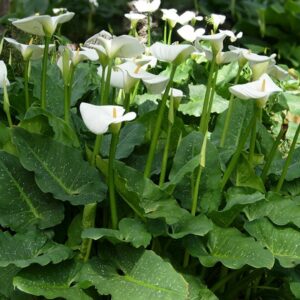Your cart is currently empty!
Unveiling the Hardy White Calla Lily: A Comprehensive Guide

Introduction
The hardy white calla lily, a striking and graceful flower, adds an elegant touch to any garden. Native to South Africa, this resilient plant has become a beloved choice for gardeners worldwide. With its distinct trumpet-shaped blooms and glossy foliage, the hardy white calla lily is a must-have for flower enthusiasts. This comprehensive guide will provide detailed information on its growth, care, and enchanting beauty.
Characteristics and Varieties
Distinctive Features
* Large, trumpet-shaped blooms in pristine white
* Glossy, deep green foliage with a heart-shaped base
* Can reach heights of up to 3 feet
* Prefers moist, well-drained soil in partial shade
Varieties
* ‘Ivory Tower’: Tall, elegant stems with large, pure white blooms
* ‘Green Goddess’: Distinctive green-tinted blooms with a unique charm
* ‘Arum Lily’: Classic variety known for its pure white trumpet-shaped flowers
* ‘Cape Coast’: Dwarf variety with compact growth and delicate white blooms
Growth Requirements
Climate and Soil
* Thrives in USDA hardiness zones 7-10
* Prefers well-drained, fertile soil with a slightly acidic pH
* Can tolerate full sun to partial shade, although afternoon shade is preferred
Planting
* Plant bulbs 4-6 inches deep and 12 inches apart in spring or fall
* Water well after planting and keep the soil consistently moist
Care Tips
Watering
* Keep the soil moist but not waterlogged
* Water regularly, especially during dry periods
* Reduce watering in the winter when the plant is dormant
Fertilization
* Fertilize monthly with a balanced fertilizer during the growing season
* Use a fertilizer specifically formulated for bulbs
Pruning
* Remove faded flowers and yellowed leaves to promote new growth
* Cut back foliage completely once it has died back in the fall
Mulching
* Spread a layer of organic mulch around the plant to retain moisture and suppress weeds
Pests and Diseases
Common Pests
* Aphids: Tiny insects that suck sap from leaves
* Thrips: Small, winged insects that damage flowers and foliage
Diseases
* Bacterial soft rot: Causes leaves and stems to turn mushy
* Fusarium wilt: Fungal disease that affects the plant’s roots and vascular system
Overwintering
* In colder climates, dig up the bulbs in the fall after the foliage dies back
* Store the bulbs in a cool, dry place over the winter
* Replant the bulbs in the spring once the soil has warmed
Propagation
* Hardy white calla lilies can be propagated by dividing the bulbs
* Dig up the bulbs in spring or fall and separate the bulblets
* Replant the bulblets and water well
Culinary and Medicinal Uses
While the hardy white calla lily is known primarily as an ornamental plant, it does have some culinary and medicinal applications.
Culinary
* The young corms of the plant can be cooked and eaten, although they are not commonly consumed
* The leaves are toxic and should not be ingested
Medicinal
* In traditional medicine, the plant has been used as an antiseptic and anti-inflammatory agent
* It is important to note that the hardy white calla lily is toxic and should only be used under the guidance of a qualified healthcare professional
Conclusion
The hardy white calla lily is a beautiful and versatile plant that brings elegance to any garden. Its distinct trumpet-shaped blooms and glossy foliage make it a favorite among gardeners. With proper care and cultivation, these resilient plants can thrive for many years, providing a touch of timeless beauty. Whether you are a seasoned gardener or a beginner, the hardy white calla lily is an excellent choice to add to your collection.








Leave a Reply